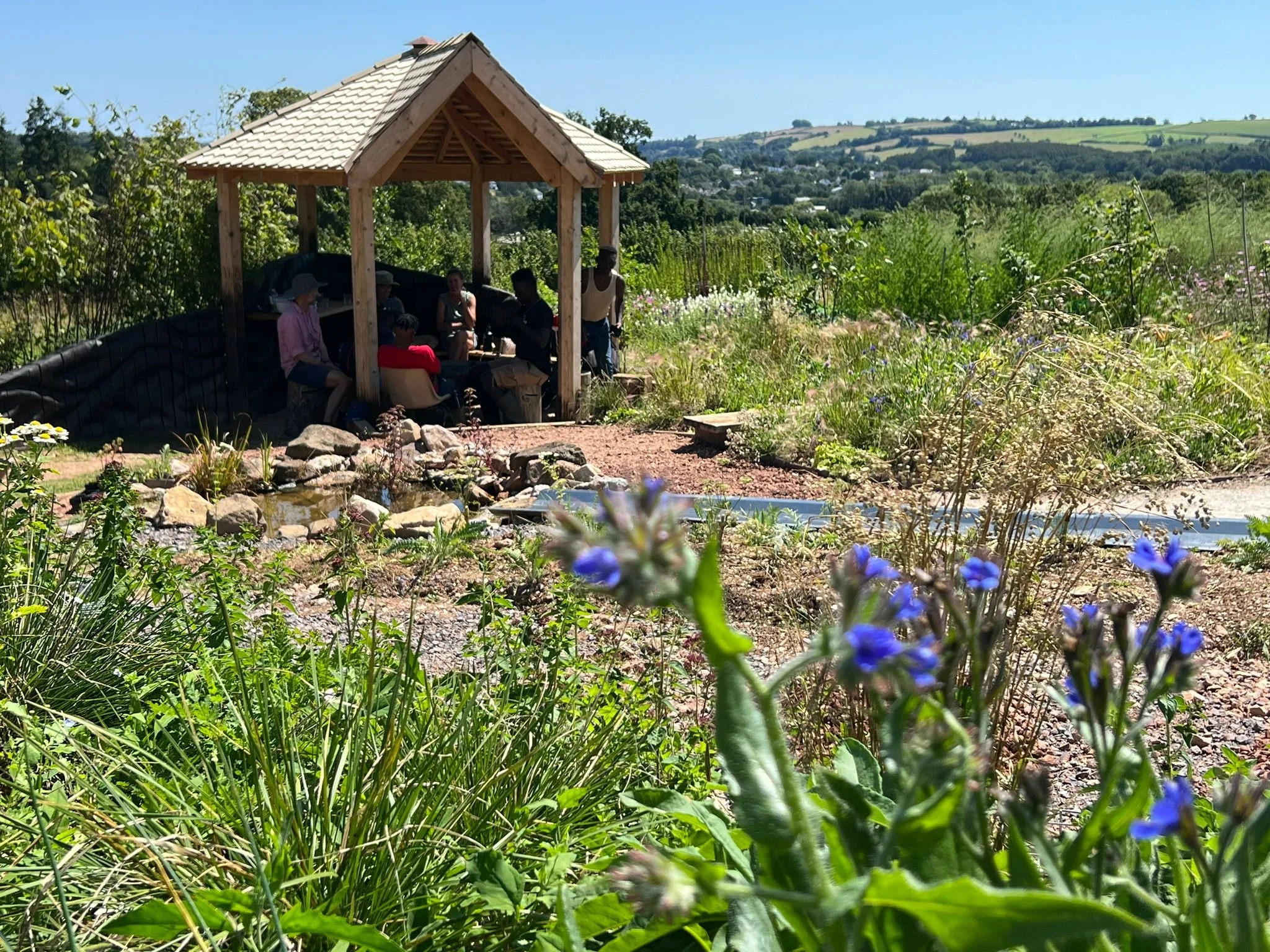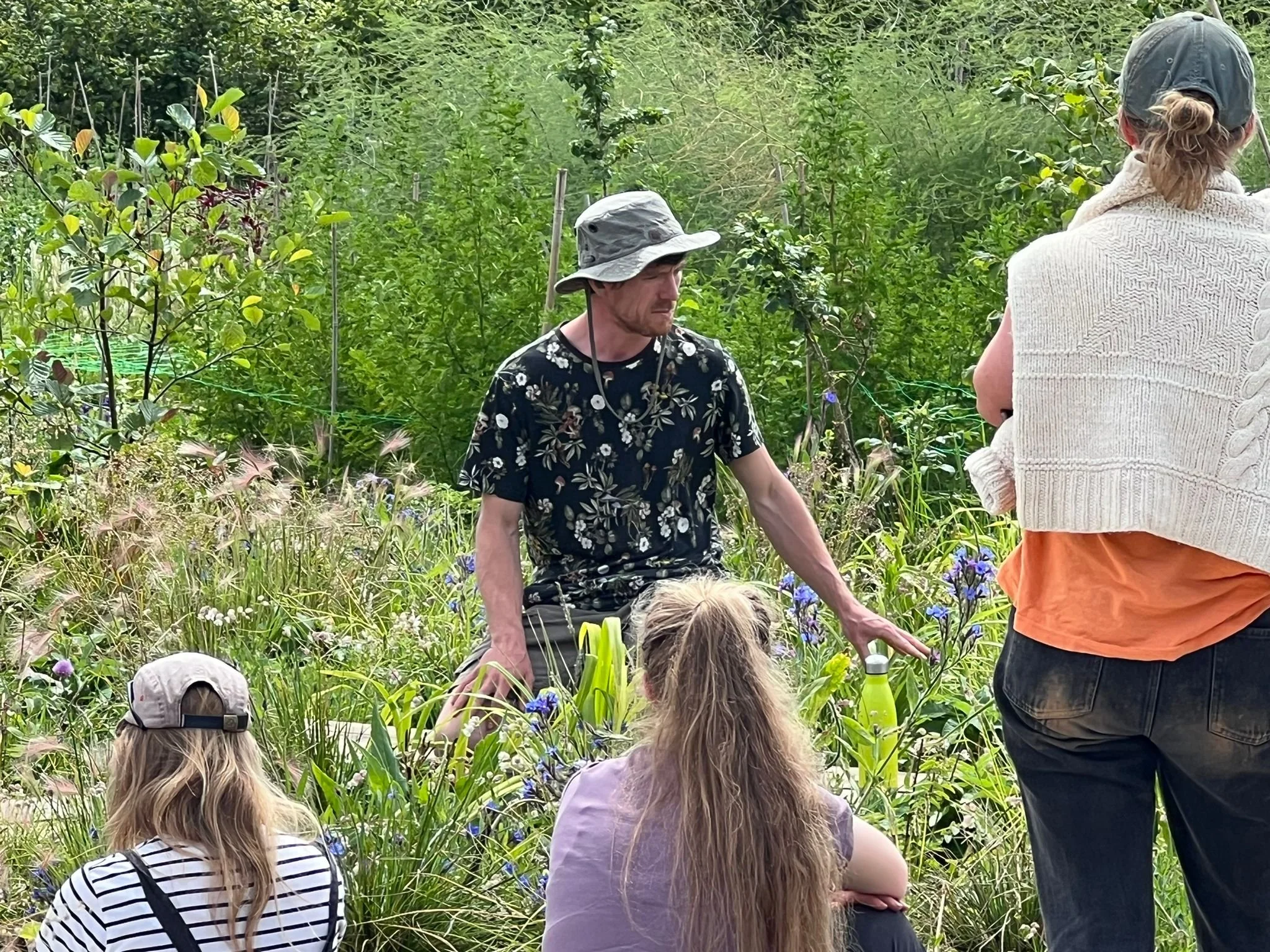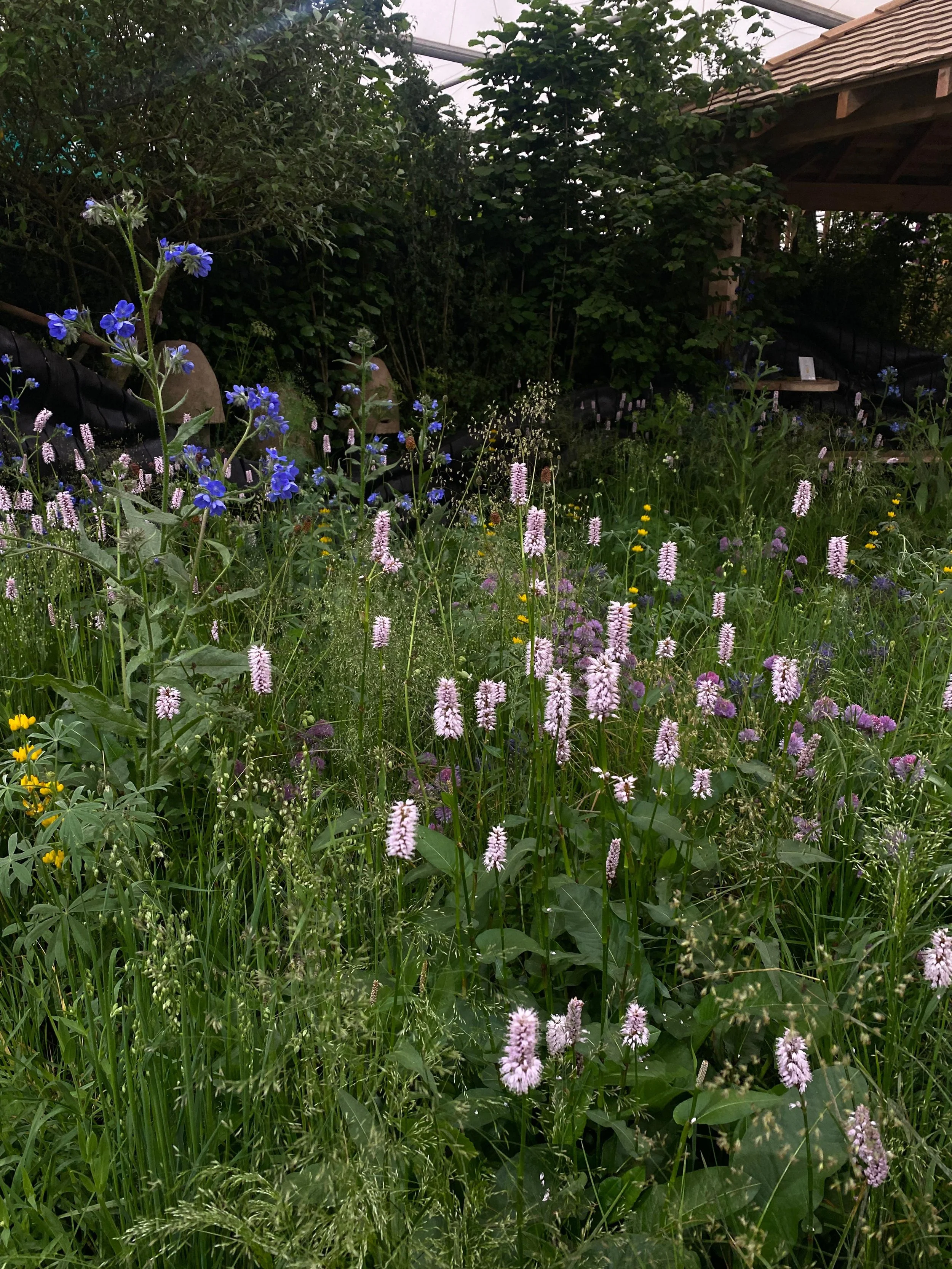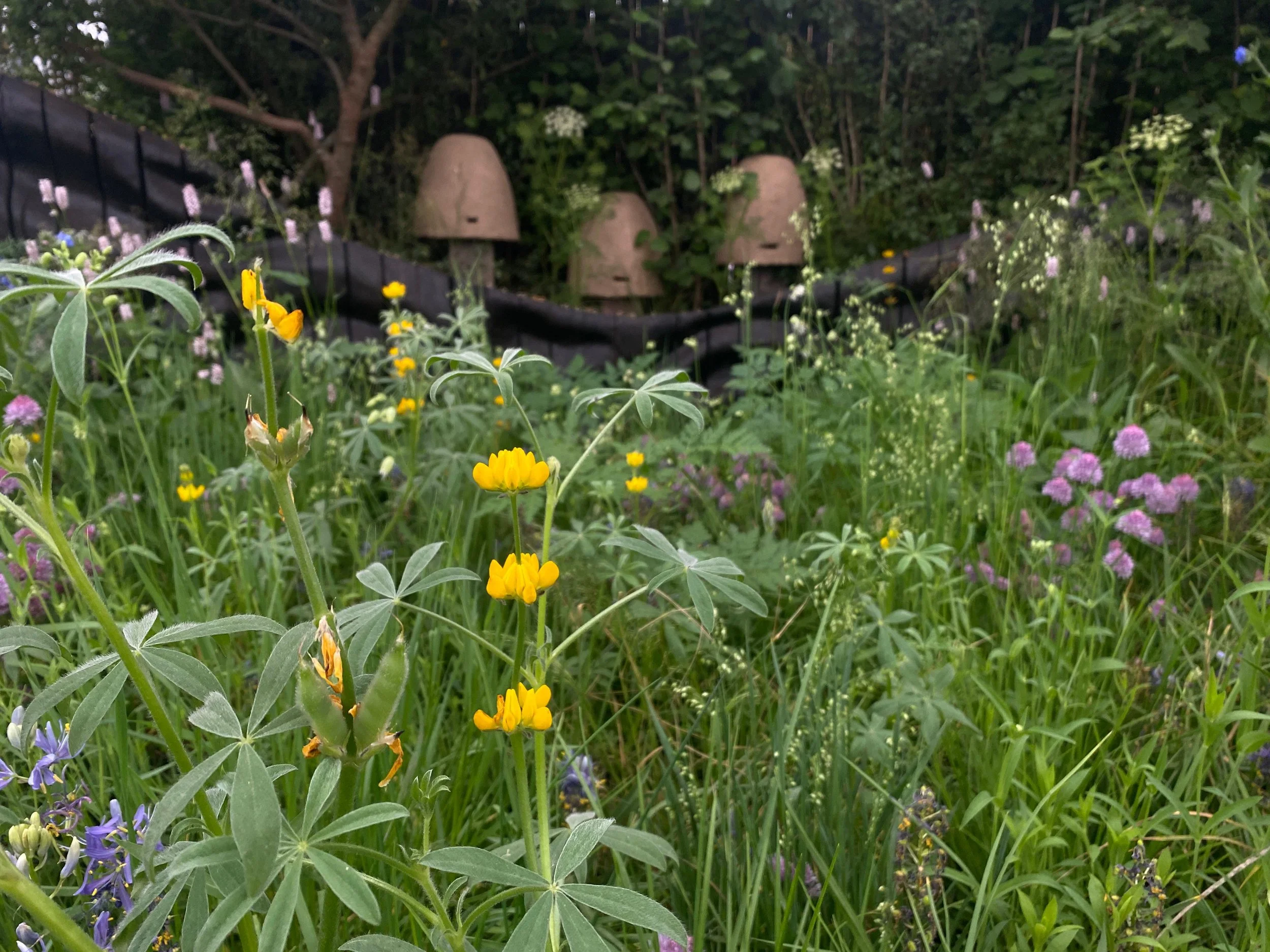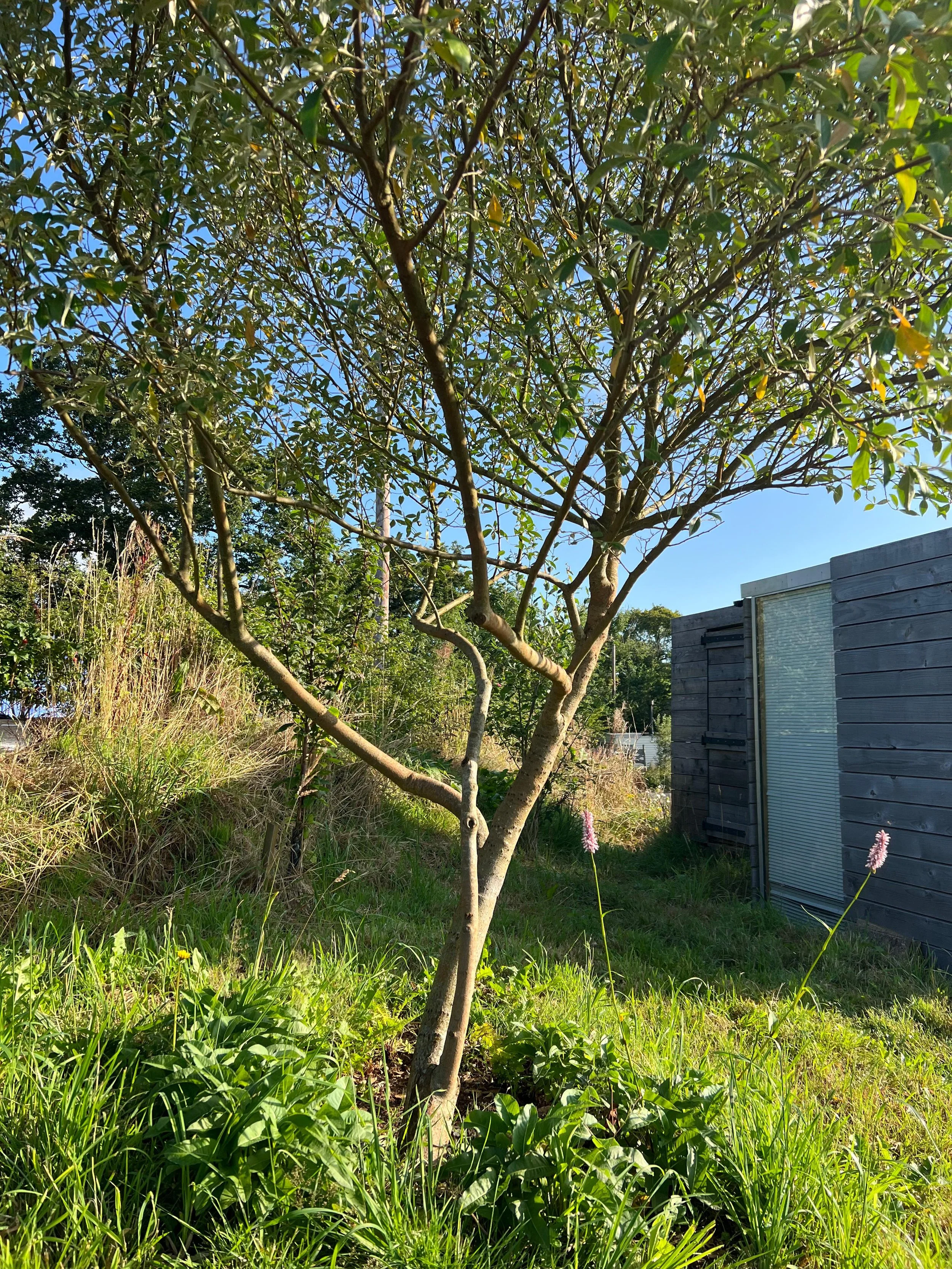Microbiome and Wellbeing Garden
(‘Ecos’ - Being at Home)
In May 2024, the Microbiome Garden was relocated from the Chelsea Flower Show to its final home at the Apricot Centre within the existing Wellbeing Garden, having received a Gold Medal in the 'All About Plants' category for its pioneering design and impactful message. The garden is dedicated to supporting young people, families, and the wider community, providing a welcoming space (or ‘ecos’ - home) for diversity of life experience, both human and nature. This garden enhances the wellbeing garden and also serves as a living example of the connection between our environment and our health.
Apricot Centre Wellbeing Service
The Apricot Centre offers a comprehensive wellbeing and Adoption Support Service for Children and Families in South Devon (as well as in East Anglia) and is also enriched by volunteering asylum seekers (and other volunteers from the local community) who have helped us to prepare this garden.
A Wellbeing Garden for Children and Young People
The Microbiome Garden is part of the Wellbeing Garden for Children, originally co-designed with a cohort of permaculture design students in 2022. Themes for the garden include connecting; the elements, curiosity and play. The design has evolved to include spaces for sensory integration in nature and exploring our relationship with food (mind, food, fun). The microbiome theme seamlessly weaves together the relationships between the inner (‘gut’) and the outer (‘garden’) together with the wider macrobiome or bioregion. A rustic (sweet chestnut) ‘welcome gate’ provides an entrance to a place where children (and adults) can feel welcome or at home (‘ecos’). It is wonderful to see how children now enter the garden with a sense of awe.
Concept Behind the Microbiome Garden
The Microbiome Garden explores the fascinating connection between a healthy landscape, a healthy gut, and a healthy mind. It features an edible meadow inspired by wild meadows, combining ornamental grasses and edible perennials to create a rich tapestry of colours and textures. The relationship between the gut biome and mental and physical health is well-documented, with research indicating that a diverse gut microbiome can enhance immune function, reduce inflammation, and even influence mood and mental health.
Microbiome Garden Designers and Partners
Sid Hill - Lecturing on Ecological Gardening and the ‘Gut Biome’ (photo credit: Mark O’Connell)
Sid Hill
Sid Hill has 15 years of experience managing a landscape business and holds a 1st Class Honours degree in Ethnobotany & Landscape Design from the Eden Project. His work has received international recognition and has been featured on BBC Gardeners' World, BBC A Country Summer, Gardens Illustrated Magazine, and Garden Masterclass. Sid was awarded the Prince of Wales Trophy for Sustainable Horticulture and the 30 Under 30 award by Pro Landscaper. He is dedicated to creating landscapes that echo wild plant communities, support biodiversity, grow food ecologically, and improve people’s lives.
Chris Hull
Chris Hull has over 16 years of experience working in horticulture and garden design and holds a BSc Hons in Garden Design from Sparsholt College. He is a regular presenter on the BBC TV show Garden Rescue and runs his own business, Greenbook Landscape Design Ltd, which focuses on designing sustainable gardens using locally sourced materials and creating diverse plantings. In 2020, Chris won the Pro Landscaper’s ‘30 Under 30 Award,’ and his work has been featured in Pro Landscaper magazine and Dream Garden magazine.
Bowel Research UK
The Microbiome Garden (funded by ‘Project Giving Back’) is a theme garden for Bowel Research UK, a national charity whose mission is to save and improve people’s lives by funding cutting-edge treatments for bowel disease through investing in the best science. Bowel Research UK is committed to advancing research into the gut microbiome, including a recent study by Imperial College that opens up the prospect of precision medicine for bowel cancer patients based on their individual gut microbiota.
Pioneering Edible Meadow
The planting scheme takes inspiration from wild meadows, with a mix of ornamental grasses such as Deschampsia cespitosa, Sesleria autumnalis, Briza media, and Hordeum jubatum, which combine with edible perennials to offer a harvest for both people and wildlife. The pioneering ‘edible meadow’ combines a selection of feature plants including Persicaria bistorta, Camassia quamash, and Lupinus luteus, to create a rich tapestry of yellows, blues, and pinks. This trio of beautiful plants are commonly grown in gardens across the UK, but few people know that they are great food crops too and they could offer a myriad of gut health and microbiome benefits.
Key Plants from the Microbiome Garden Design
Edible Meadow Theme Plants
Camassia quamash (Camas) (photo credit: Jacob Gibbins)
Persicaria bistorta (Bistort)
Camassia quamash (Camas): These edible bulbs were a staple food for Native American tribes. They need to be cooked for a long time to break down inulin. It is said that the well cooked bulbs have a flavour similar to baked pear, fig or chestnut.
Persicaria bistorta (Bistort): The young leaves and shoots are edible and can be cooked like spinach or added to salads. In Northern England the leaves used to be mixed with nettles, onions and oatmeal to make ‘Dock Pudding’, a dish traditionally served during Lent or Easter.
Lupinus luteus (Yellow Lupin): Whose seeds are used as food after proper processing to remove bitterness and alkaloids. The roasted seeds can be used as a coffee substitute. Rich in protein (30-40%) and fibre.
Grasses
Deschampsia cespitosa (Tufted Hairgrass): Propagated by seed or division, used for erosion control and ornamental purposes.
Sesleria autumnalis (Autumn Moor Grass): Evergreen grass that adapts to various soil types, providing a backdrop for other plants.
Briza media (Quaking Grass): Low-maintenance, hardy grass that adds an informal touch to gardens.
Hordeum jubatum (Foxtail Barley): Tolerates saline soils and is used for ornamental purposes.
Filler Plants
Lupinus luteus (Yellow Lupin) (photo credit: Jacob Gibbins)
Myrrhis odorata (Sweet Cicely): Leaves and stems are used in salads and as a sweetener.
Silene vulgaris (Bladder Campion): Young leaves are edible and can be cooked.
Anthriscus cerefolium (Chervil): Leaves are used in salads and as a herb.
Anchusa Azurea (Italian Bugloss): Young leaves are edible raw or cooked. (see photo)
Anethum graveolens (Dill): Leaves and seeds are used as a herb.
Aquilegia vulgaris (European Columbine): Nectar-rich flowers.
Allium schoenoprasum (Chives): Leaves and flowers are used in culinary applications.
Viola odorata (Sweet Violet): Flowers and leaves are used in salads and desserts.
Trees
Eleagnus umbellata (Autumn Olive) (photo credit: Mark O’Connell)
Elaeagnus umbellata: Known for its edible berries, which are rich in antioxidants and vitamins. Also known as the Autumn Olive Tree: Now to be found just inside the garden entrance gate.
Sambucus nigra (Elderberry): Berries and flowers are used in traditional medicine and culinary applications.
Corylus avellana (Hazel): Produces edible nuts that are rich in healthy fats and proteins.
Viburnum lantana: Known for its ornamental value and edible berries.
Acer campestre (Field Maple): Used for its sap and ornamental value.
Crataegus monogyna (Hawthorn): Berries, leaves, and flowers are used in traditional medicine for heart health.
Additional Edible Plants
Daylilies (Hemerocallis spp.): Edible flowers and tubers. Varieties like Hemerocallis fulva are particularly flavorful.
Thyme and Oregano: Common culinary herbs that support gut health.
Mashua and Oca: Tubers rich in prebiotic fibers, promoting gut health.
Ostrich Ferns, Marigolds, Inula, Yarrow: Edible plants with various health benefits.
Hedging Plants: Dog rose, hazelnuts, and walnuts provide edible fruits and nuts.
The Hive Structure and Sculptural Wall
The ‘Hive’ and Sculptural (gut) wall
The Hive is a hexagonal shelter made from sustainable materials, providing a space for gathering and food preparation. The serpentine charred-oak sculptural wall, carved by Sid Hill, represents the gut biome and reflects the surrounding bioregion or macrobiome.
Recipes Using ‘Microbiome’ Theme Plants
Roasted Camas Bulbs
Ingredients: Camassia quamash bulbs, olive oil, salt, lemon juice.
Method: Preheat oven to 220°C. Clean and peel camas bulbs. Place in an ovenproof dish with a bit of water, cover, and bake for 12 hours. Once cooked, slice and sauté in olive oil until golden. Season with salt and lemon juice before serving.
Bistort and Nettle Pudding
Ingredients: Young bistort leaves, nettle tops, spring onions, oatmeal, salt, pepper.
Method: Boil bistort leaves and nettle tops until tender. Drain and chop finely. Mix with chopped spring onions and oatmeal. Form into patties and fry until golden. Season with salt and pepper.
Yellow Lupin Bean Salad
Ingredients: Yellow lupin seeds, garlic, lemon juice, olive oil, salt, pepper.
Method: Soak lupin seeds overnight, then boil for an hour. Drain and cool. Mix with minced garlic, lemon juice, olive oil, salt, and pepper. Serve chilled as a salad.
Diversity in Gardens
This garden has in great part been landscaped, planted and maintained together with enthusiastic volunteering asylum seekers from the DIG project coming both from Torbay, Totnes and Plymouth. Diversity in Gardens (DIG) operates in South Devon, addressing economic and social inequality by providing diverse communities with access to innovative land-based projects. A collaboration between Radical Ecology, The Apricot Centre, and Devon and Cornwall Refugee Support (DCRS), DIG emphasizes the importance of diversity for regenerating land, lives, and livelihoods, fostering cultural exchange, and connecting people with nature.
DIG aims to create inclusive green spaces and develop food cultivation skills, promoting equality, diversity, and compassion. It targets marginalized communities, offering practical opportunities for growing, eating, learning, and working together. DIG's vision includes skill development, wellbeing enhancement, and potential employment through initial volunteering and network development, thereby integrating diversity into the community fabric.
Partners Involved
Bowel Research UK: Funded the garden and supports research on the gut microbiome.
Project Giving Back: Supported the garden's relocation and development.
Apricot Centre: Hosts the garden and provides wellbeing services.
Atlantes Landscaping: Assisted with the garden build and structural elements.
Volunteers from the ‘Diversity in Gardens’ project - asylum seekers from Torbay, Totnes and Plymouth.
Compiled by Mark O’Connell - Registered Manager and Process Oriented Child Psychotherapist - Wellbeing Service and Adoption Support Service
12th July 2024
Download PDF here

